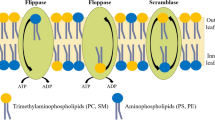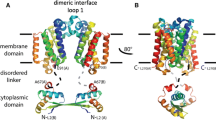Summary
Although hydrophobic forces probably dominate in determining whether or not a protein will insert into a membrane, recent studies in our laboratory suggest that electrostatic forces may influence the final orientation of the inserted protein. A negatively charged hepatic receptor protein was found to respond totrans-positive membrane potentials as though “electrophoresing” into the bilayer. In the presence of ligand, the protein appeared to cross the membrane and expose binding sites on the opposite side. Similarly, a positively charged portion of the peptide melittin crosses a lipid membrane reversibly in response to atrans-negative potential. These findings, and others by Date and co-workers, have led us to postulate that transmembrane proteins would have hydrophobic transmembrane segments bracketed by positively charged residues on the cytoplasmic side and negatively charged residues on the extra-cytoplasmic side. In the thermodynamic sense, these asymmetrically placed charge clusters would create a compelling preference for correct orientation of the protein, given the inside-negative potential of most or all cells. This prediction is borne out by examination of the few transmembrane proteins (glycophorin, M13 coat protein, H-2Kb, HLA-A2, HLA-B7, and mouse Ig μ heavy chain) for which we have sufficient information on both sequence and orientation.
In addition to the usual diffusion and pump potentials measurable with electrodes, the “microscopic” membrane potential reflects surface charge effects. Asymmetries in surface charge arising from either ionic or lipid asymmetries would be expected to enhance the bias for correct protein orientation, at least with respect to plasma membranes. We introduce a generalized form of Stern equation to assess surface charge and binding effects quantitatively. In the kinetic sense, dipole potentials within the membrane would tend to prevent positively charged residues from crossing the membrane to leave the cytoplasm. These considerations are consistent with the observed protein orientations. Finally, the electrostatic and hydrophobic factors noted here are combined in two hypothetical models of translocation, the first involving initial interaction of the presumptive transmembrane segment with the membrane; the second assuming initial interaction of a leader sequence.
Similar content being viewed by others
References
Ashwell, G., Morell, A.G. 1974. The role of surface carbohydrates in the hepatic recognition and transport of circulating glycoproteins.Adv. Enzymol. 41:99–128
Beeler, T., Russell, J.T., Martonosi, A. 1979. Optical probe responses on sarcoplasmic reticulum: Oxacarbocyanines as probes of membrane potential.Eur. J. Biochem. 95:579–591
Blobel, G., Dobberstein, B. 1974a. Transfer of proteins across membranes. I. Presence of proteolytically processed and unprocessed nascent immunoglobulin light chains on membrane-bound ribosomes of murine myeloma.J. Cell Biol. 67:835–851
Blobel, G., Dobberstein, B. 1974b. Transfer of proteins across membranes. II. Reconstitution of functional rough microsomes from heterologous components.J. Cell Biol. 67:852–862
Blumenthal, R., Klausner, R.D. 1981. The interaction of proteins with black lipid membranes.Cell Surf. Rev. (in press)
Blumenthal, R., Klausner, R.D., Weinstein, J.N. 1980. Voltage-dependent translocation of the asialoglycoprotein receptor across lipid membranes.Nature (London) 288:333–338
Blumenthal, R., Shamoo, A.E. 1979. Incorporation of transport molecules into black lipid membranes.In: The Receptors. R.D. O'Brien, editor. Vol. 1, pp. 215–245 Plenum Press, New York
Bockris, O'M., Reddy, A.K.N. 1970. Modern Electrochemistry. Plenum Press, New York
Bollen, I.C., Higgins, J.A. 1980. Phospholipid asymmetry in rough- and smooth-endoplasmic reticulum membranes of untreated and phenobarbital-treated rat liver.Biochem. J. 189:475–480
Coligan, J.E., Kindt, T.J., Uehara, H., Martinko, J., Nathenson, S.G. 1981. The complete primary structure of a murine transplantation antigen: A membrane-bound molecule analyzed by radiochemical techniques.Nature (London) (in press)
Data, T., Goodman, J.M., Wickner, W.T. 1980. Procoat, the precursor of M13 coat protein, requires an electrochemical potential for membrane insertion.Proc. Natl. Acad. Sci. USA 77:4669–4673
Date, T., Zwizinski, C., Ludmerer, S., Wickner, W. 1980. Mechanisms of membrane assembly: Effects of energy poisons on the conversion of soluble M13 coliphage procoat to membrane-bound coat protein.Proc. Natl. Acad. Sci. USA 77:827–831
Dayhoff, M.O., Hunt, L.T., Barker, W.C., Schwartz, R.M., Yeh, L.-S., Orcutt, B.C. 1981.Protein Sequence Reference Data Base. Natl. Biomed. Res. Found., Washington, D.C. March, 1981
DePierre, J.W., Dallner, G. 1975. Structural aspects of the membrane of the endoplasmic reticulum.Biochim. Biophys. Acta 415:411–472
Ehrenstein, G., Lecar, H. 1977. Electrically gated ion channels in lipid bilayers.Q. Rev. Biophys. 10:1–344
Eisenberg, M., Gresalfi, T., Riccio, T., McLaughlin, S. 1979. Adsorption of monovalent cations to bilayer membranes containing negative phospholipids.Biochemistry 18:5213–5223
Engelman, D.M., Henderson, R., McLachlan, A.D., Wallace, B.A. 1980. Path of the polypeptide in bacteriorhodopsin.Proc. Natl. Acad. Sci. USA 77:2025–2027
Engelman, D.M., Steitz, T.A. 1981. The spontaneous insertion of proteins into and across membranes: The helical hairpin hypothesis.Cell 23:411–422
Finkelstein, A., Rubin, L.L., Tzeng, M. 1976. Black widow spider venom: Effect of purified toxin on lipid bilayer membranes.Science 193:1009–1011
Gilbert, D.L., Ehrenstein, G. 1969. Effect of divalent cations on potassium conductance of squid axons: Determination of surface charge.Biophys. J. 9:447–463
Grahame, D.C. 1947. The electrical double layer and the theory of electrocapillarity.Chem. Rev. 41:441–501
Harold, F.M., Van Brunt, J. 1977. Circulation of H+ and K+ across the plasma membrane is not obligatory for bacterial growth.Science 197:372–373
Henkart, P., Blumenthal, R. 1975. Interaction of lymphocytes with lipid bilayer membranes: A model for lymphocyte-mediated lysis of target cells.Proc. Natl. Acad. Sci. USA 72:2789–2793
Higgins, J.A., Dawson, R.M.C. 1977. Asymmetry of the phospholipid bilayer of rat liver endoplasmic reticulum.Biochim. Biophys. Acta 470:342–356
Hladky, S.B., Haydon, D.A. 1973. Membrane conductance and surface potential.Biochim. Biophys. Acta 318:464–468
Hodgkin, A.L., Huxley, A.F. 1952. A quantitative description of membrane current and its application to conduction and excitation in nerve.J. Physiol. (London) 117:500–544
Inouye, M., Halegoua, S. 1980. Secretion and membrane localization of proteins inEscherichia coli.Crit. Rev. Biochem. 10:339–371
Kempf, C., Klausner, R.D., Weinstein, J.N., Van Renswoude, J., Pincus, M., Blumenthal, R. 1982. Voltage-dependent transbilayer orientation of melittin.J. Biol. Chem. (in press)
Klausner, R.D., Bridges, K., Tsunoo, H., Blumenthal, R., Weinstein, J.N., Ashwell, G. 1980. Reconstitution of the hepatic asialoglycoprotein receptor with phospholipid vesicles.Proc. Natl. Acad. Sci. USA 77:5087–5091
Klausner, R.D., Kleinfeld, A., Hoover, R., Karnovsky, M.J. 1980. Lipid domains in membranes.J. Biol. Chem. 255:1286–1295
Marchesi, V.T., Furthmayr, H., Tomita, M. 1976. The red cell membrane.Annu. Rev. Biochem. 45:667–698
McLaughlin, A., Grathwohl, C., McLaughlin, S. 1978. The adsorption of divalent cations to phosphatidylcholine bilayer membranes.Biochim. Biophys. Acta 513:338–357
McLaughlin, S. 1977. Electrostatic potentials at membrane-solution interfaces.Curr. Top. Membr. Trans. 9:71–144
McLaughlin, S., Harary, H. 1974. Phospholipid flip-flop and distribution of surface charges in excitable membranes.Biophys. J. 14:200–208
McLaughlin, S., Mulrine, N., Gresalfi, T., Vaio, G., McLaughlin, A. 1981. Adsorption of divalent cations to bilayer membranes containing phosphatidylserine.J. Gen. Physiol. 77:445–473
Michaels, D.W., Abramovitz, A.S., Hammer, C.H., Mayer, M.M. 1976. Increased ion permeability of planar lipid bilayer membranes after treatment with the C5b-9 cytolytic attack mechanism of complement.Proc. Natl. Acad. Sci. USA 73:2652–2656
Miller, C., Rosenberg, R.L. 1979. Modification of a voltage-gated K+ channel from sarcoplasmic reticulum by a pronase-derived specific endopeptidase.J. Gen. Physiol. 74:457–478
Moore, L., Pastan, I. 1978. Energy-dependent calcium uptake by fibroblast microsomes.Ann. N.Y. Acad. Sci. 307:177–194
Nakashima, Y., Konigsberg, W. 1974. Reinvestigation of a region of thefd bacteriophage coat protein sequence.J. Mol. Biol. 88:598–600
Nilsson, O.S., Dallner, G. 1977a. Transverse asymmetry of phospholipids in subcellular membranes of rat liver.Biochim. Biophys. Acta 464:453–458
Nilsson, O.S., Dallner, G. 1977b. Enzyme and phospholipid asymmetry in liver microsomal membranes.J. Cell Biol. 72:568–583
Op den Kamp, J.A.F. 1979. Lipid asymmetry in membranes.Annu. Rev. Biochem. 48:47–71
Robb, R.J., Terhorst, C., Strominger, J.L. 1978. Sequence of the COOH-terminal hydrophilic region of histocompatibility antigens HLA-A2 and HLA-B7.J. Biol. Chem. 253:5319–5324
Robinson, G.B. 1975. The isolation and composition of membranes.In: Biological Membranes. D.S. Parsons, editor. p. 8. Clarendon Press, Oxford
Rogers, J., Early, P., Carter, C., Calame, K., Bond, M., Hood, L., Wall, R. 1980. Two mRNAs with different 3′ends encode membrane-bound and secreted forms of immunoglobin muchain.Cell 20:303–312
Rothman, J.E., Lenard, J. 1977. Membrane asymmetry.Science 195:743–747
Schein, S.J., Colombini, M., Finkelstein, A. 1976. Reconstitution in planar lipid bilayers of a voltage-dependent anion-selective channel obtained from paramecium mitochondria.J. Membrane Biol. 30:99–120
Schein, S.J., Kagan, B.L., Finkelstein, A. 1978. Colicin K+ acts by forming voltage dependent channels in phospholipid bilayer membranes.Nature (London) 276:159–163
Steiner, D.F., Quinn, P.S., Chan, S.J., Marsh, J., Tager, H.S. 1980. Processing mechanisms in the biosynthesis of proteins.Ann. N.Y. Acad. Sci. 343:1–16
Sundler, R., Sarcione, S.L., Alberts, A.W., Vagelos, P.R. 1977. Evidence against phospholipid asymmetry in intracellular membranes from liver.Proc. Natl. Acad. Sci. USA 74:3350–3354
Von Heijne, G., Blomberg, C. 1979. Trans-membrane translocation of proteins: The direct transfer model.Eur. J. Biochem. 97:175–181
Waggoner, A.S. 1979. Dye indicators of membrane potential.Annu. Rev. Biophys. Bioeng. 8:47–68
Wickner, W. 1980. Assembly of proteins into membranes.Science 210:861–868
Wojtczak, L., Nalecz, M.J. 1979. Surface charge of biological membranes as a possible regulator of membrane-bound enzymes.J. Biochem. 94:99–107
Zimniak, P., Racker, E. 1978. Electrogenicity of Ca++ transport catalyzed by the Ca++-ATPase from sarcoplasmic reticulum.J. Biol. Chem. 253:4631–4637
Author information
Authors and Affiliations
Rights and permissions
About this article
Cite this article
Weinstein, J.N., Blumenthal, R., van Renswoude, J. et al. Charge clusters and the orientation of membrane proteins. J. Membrain Biol. 66, 203–212 (1982). https://doi.org/10.1007/BF01868495
Received:
Revised:
Issue Date:
DOI: https://doi.org/10.1007/BF01868495




